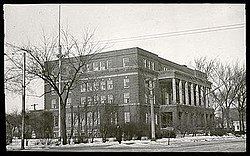Architect R. Messmer & Bros. Year built 1917 | Architectural style(s) Georgian Revival | |
 | ||
Location 5706 Eighth Ave, Kenosha, Wisconsin | ||
The Kenosha Elks Club is a historic building in Kenosha, Wisconsin. Construction began on the building in 1916 and it was formally dedicated on January 20, 1919.
Contents
History as the Elks Club
Plans to construct a club house for the Kenosha chapter of the Benevolent and Protective Order of Elks began in 1916 when 300 members pledged $65,000 for the purchase of land that formerly housed the Petit Malt House, which burned down in 1914. The land was purchased for $41,000 in June 1916 and by fall of that year, building plans by R. Messmer & Brothers had been improved and the Immel Construction Company had begun work on the site. A cornerstone was laid in June 1917, and on January 20, 1919, the club dedicated the building, which featured a hotel, swimming pool, and numerous dining facilities. Zalmon G. Simmons, founder of the Simmons Bedding Company, was among the men that made up the Building Committee.
In April 1929, the club held a gathering which drew Elks officials from all over the country to ceremoniously burn the mortgage on the building.
Sometime after 1938, the building was renovated and expanded, with an addition being added to the southwest side to house an expanded kitchen.
Throughout the years, the Elks Club played host to numerous special guests, including Mel Tormé and Colonel Sanders.
By the 1990s, the club was experiencing financial problems, and in the early 1990s the building was sold.
1990s to present
Through the early 1990s, the building passed through a number of owners and at some point was renamed the Heritage House Inn. Following an attempted (and failed) launch of a restaurant, the owners allowed the building to deteriorate, neglecting to turn off water service in the winter, which lead to burst pipes. In the late 1990s, the building was sold to local philanthropist Andrea Christensen, whose husband owned a local sheet metal factory. Christensen invested hundreds of thousands of dollars into the building, repairing the damage caused by the neglect from previous owners. The building was then leased out to a local restaurant and used as banquet facilities.
During its time as a banquet facility, the building still saw many notable guests. In April 2000, then-Speaker of the House Dennis Hastert spoke at a dinner for a Republican group.
In the mid-2000s, the restaurant operating the banquet facilities closed. At that point, the building and its property fell into disuse and abandonment.
Fire
During the afternoon of October 28, 2011, a member of the Kenosha Fire Department was passing by the building when they noticed smoke pouring out of windows on the upper floor. Five separate departments from the surrounding communities responded to the fire, which was "confined mainly to space between supporting timbers and multiple layers of flooring on the second floor" in an area that was almost in the center of the second floor ballroom. Local radio station WGTD-AM also reported that the building had recently become a "haven" for the homeless. The fire largely damaged the floor of the second floor ballroom and the spaces occupied by multiple themed dining rooms below.
Preservation and revival attempts
The City of Kenosha issued a Raze order against on December 23, 2011, at which point a group calling themselves "Preserve the Elks"[2] formed to save the building from demolition. On March 22, 2012, Kenosha's Historic Preservation Committee voted 4-1 to delay the vote on supporting or opposing the demolition by 120 days.
The City of Kenosha reports that they have fielded "several calls" from parties interested in seeing the building.
